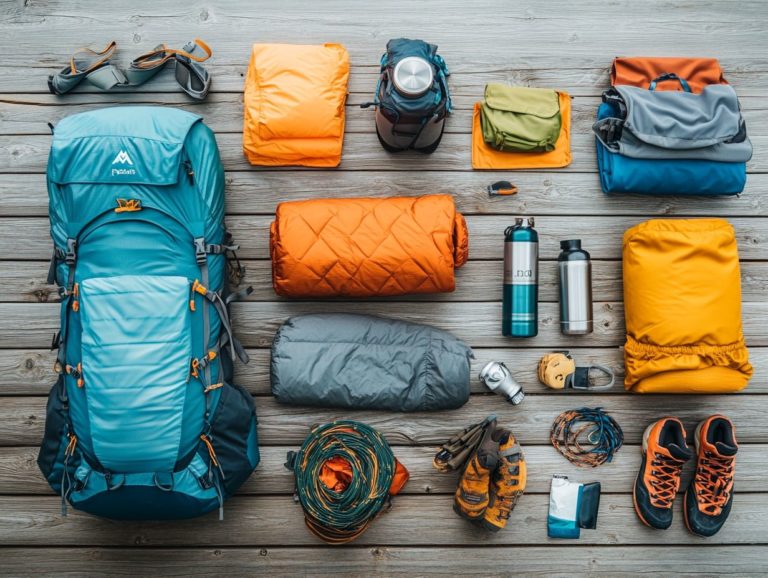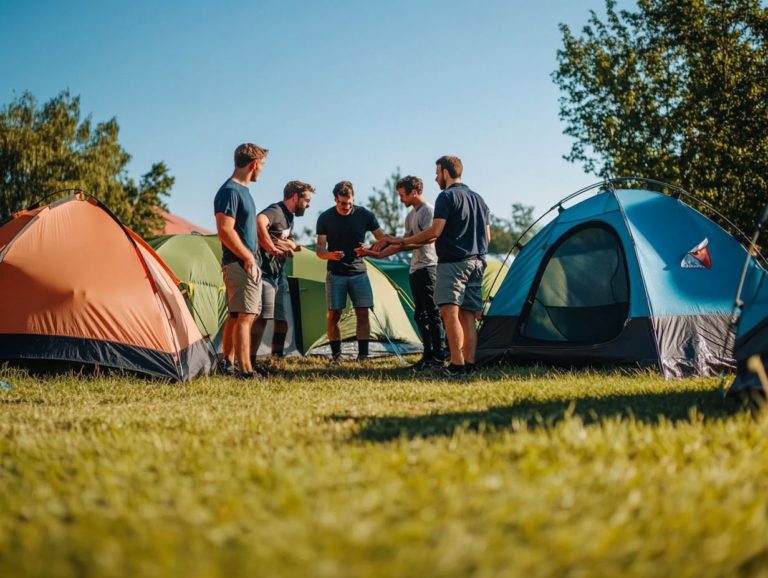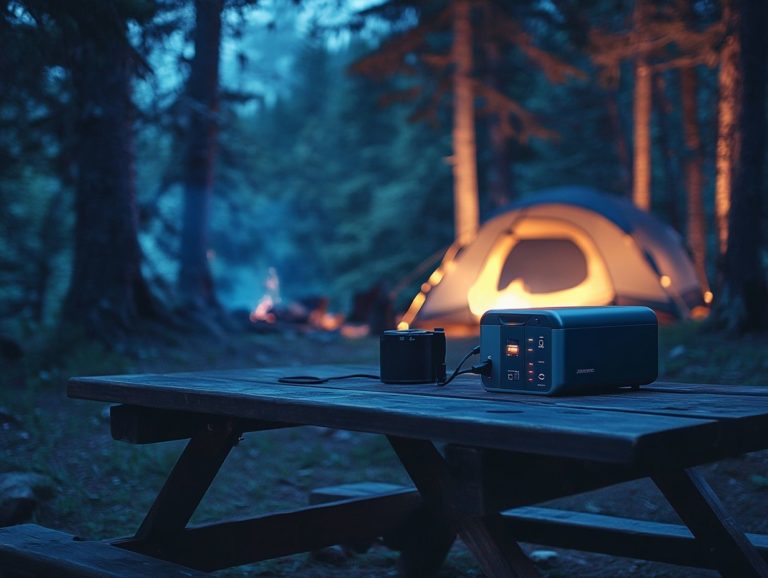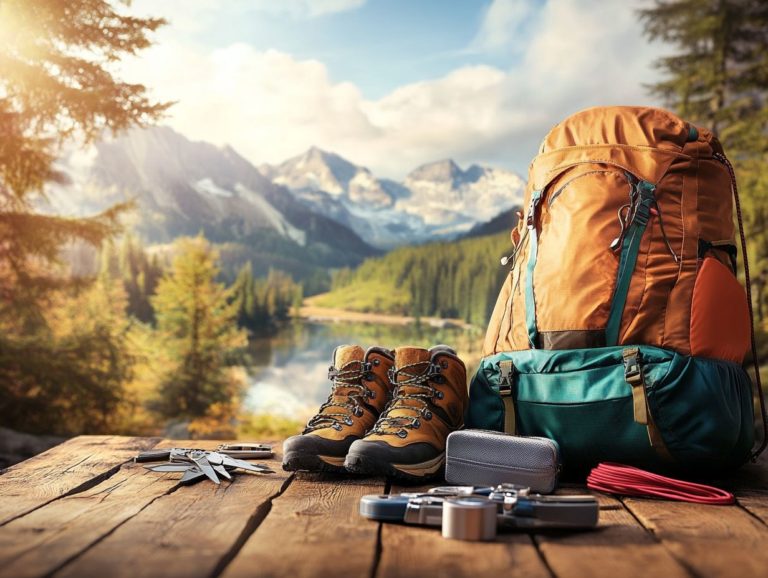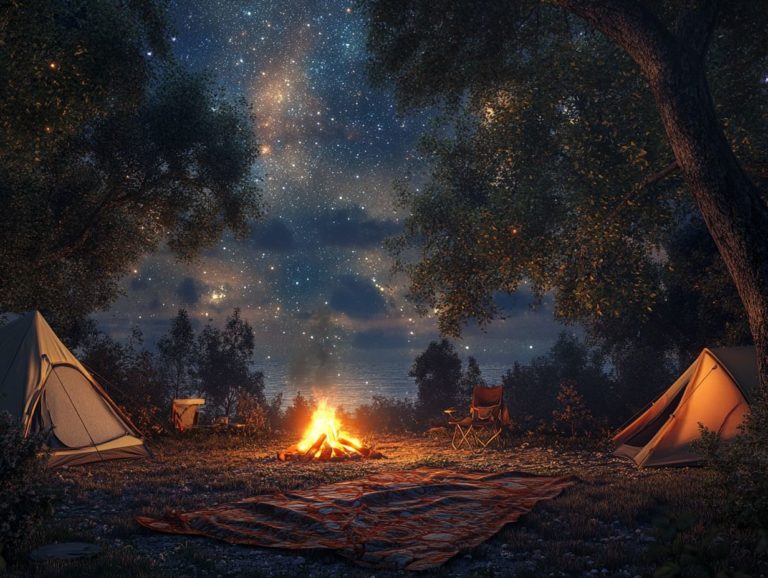How to Select the Right Camping Fuel
Choosing the right camping fuel can enhance your outdoor experience. With various options available, each tailored to specific needs and conditions, such as the best fuel for your camping stove, consider factors like your environment, stove compatibility, and cooking requirements.
This guide delves into popular types of camping fuel, including propane, butane, liquid fuel, and wood. It also provides essential storage and safety tips to ensure your adventures are enjoyable and secure.
Get ready for your next camping trip! You’ll be well-fueled and equipped for an adventure ahead!
Contents
- Key Takeaways:
- Types of Camping Fuel
- Factors to Consider when Choosing Camping Fuel
- Popular Types of Camping Fuel
- Storage and Safety Tips for Camping Fuel
- Frequently Asked Questions
- What factors should I consider when selecting the right camping fuel?
- What are the different types of camping fuel available in the market?
- Can I use any type of fuel for my camping stove?
- What is the best type of camping fuel for cold weather?
- How should I store camping fuel while on a camping trip?
- Can I bring camping fuel on a plane?
Key Takeaways:
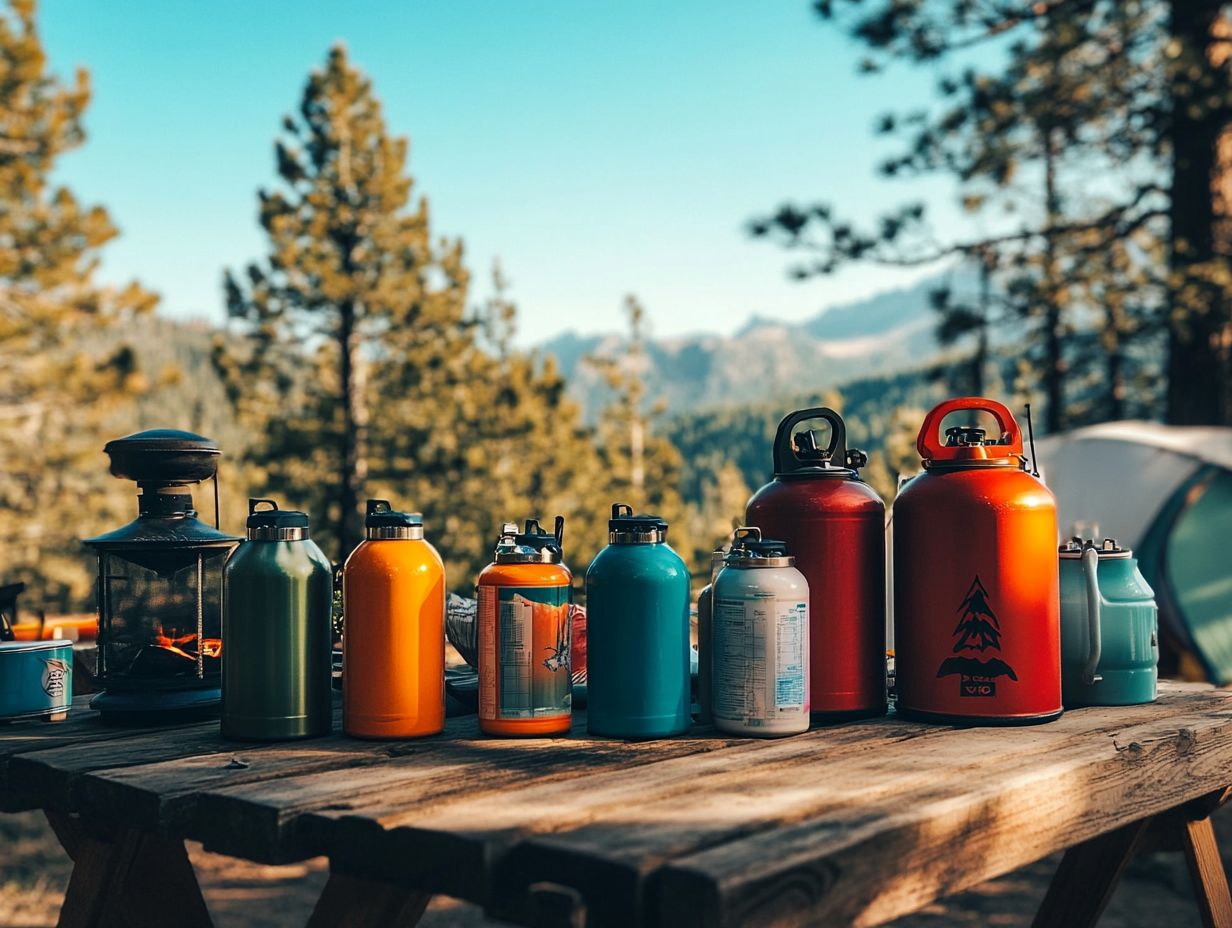
- Choose camping fuel based on the environment and climate to ensure proper combustion and optimal performance.
- Consider stove compatibility and cooking needs to determine which type of camping fuel will work best for your specific trip.
- Follow proper storage techniques and safety precautions to ensure the safe and efficient use of camping fuel during your trip.
Types of Camping Fuel
When you set out on a camping adventure, understanding the different types of camping fuel is essential for enhancing your outdoor cooking experience. If you’re using a camping stove, you’ll find fuel options such as propane-butane mixtures, pressurized canisters, and liquid fuels. Each offers distinct advantages tailored to your specific needs whether you re boiling water or whipping up a gourmet meal.
Each fuel type has unique characteristics, including heat output and flame control. Therefore, it s vital to choose fuel mixtures that best align with your camping requirements and the surrounding environmental conditions.
Factors to Consider when Choosing Camping Fuel
Selecting the ideal camping fuel requires careful consideration of several factors that can influence your outdoor cooking experience. Understanding your fuel requirements and how the fuel burns is essential.
Pay attention to flame control, as it directly impacts cooking efficiency. Temperature control is vital for various cooking methods, especially during winter camping or when you need to boil water quickly.
Every camping stove, whether it s a backpacking model from reputable brands like Coleman or MSR, has its fuel preferences. Prioritizing the best fuel type based on your specific camping conditions and cooking needs will ensure a seamless culinary adventure in the great outdoors.
Environment and Climate
The environment and climate are crucial in selecting the right camping fuel. As you embark on your outdoor adventures, adapt your gear to the weather conditions you ll face, especially during cold winter outings.
If you find yourself in high-altitude or frigid surroundings, you may need specialized fuel mixtures that guarantee reliable ignition and consistent heat output. Milder climates might allow for simpler options, like canister gas. Understanding how temperature impacts fuel performance is key to ensuring your camping stove runs smoothly.
Humidity also plays a significant role in your fuel choice. In damp conditions, liquid fuel options may struggle to ignite unless specifically designed for such environments. If you re venturing into tropical regions, alcohol-based fuels excel in high humidity.
Planning a camping trip to mountainous terrains often demands a robust fuel supply. This caters to those who need efficiency at elevations that challenge standard options. Paying attention to regional factors is essential for ensuring your cooking experiences outdoors are safe and enjoyable.
Stove Compatibility
Stove compatibility is a vital factor when choosing camping fuel. Not all camping stoves are created equal, as each type has its own fuel requirements. These requirements can significantly influence both efficiency and safety.
For instance, if you re using a backpacking stove, it may require specific fuel canisters or be optimized for liquid fuels. Traditional camping stoves often offer greater flexibility, accommodating canister gas and propane-butane mixtures. Understanding your stove s fuel requirements ensures you select the best fuel that enhances performance while minimizing potential hazards.
To navigate this compatibility landscape effectively, review the specifications provided by reputable camping stove brands like Jetboil or Coleman. Canister stoves usually require pre-filled canisters containing isobutane or propane, making them a convenient choice for short trips. Alternatively, liquid fuel stoves are often preferred by those venturing into colder climates or embarking on longer excursions, as they can utilize white gas or kerosene, offering a more versatile fuel option.
When selecting your fuel, check for compatibility and efficiency ratings. Also, consider the availability of specific fuel types. This will ensure you have the best options at your disposal for your next adventure.
Cooking Needs
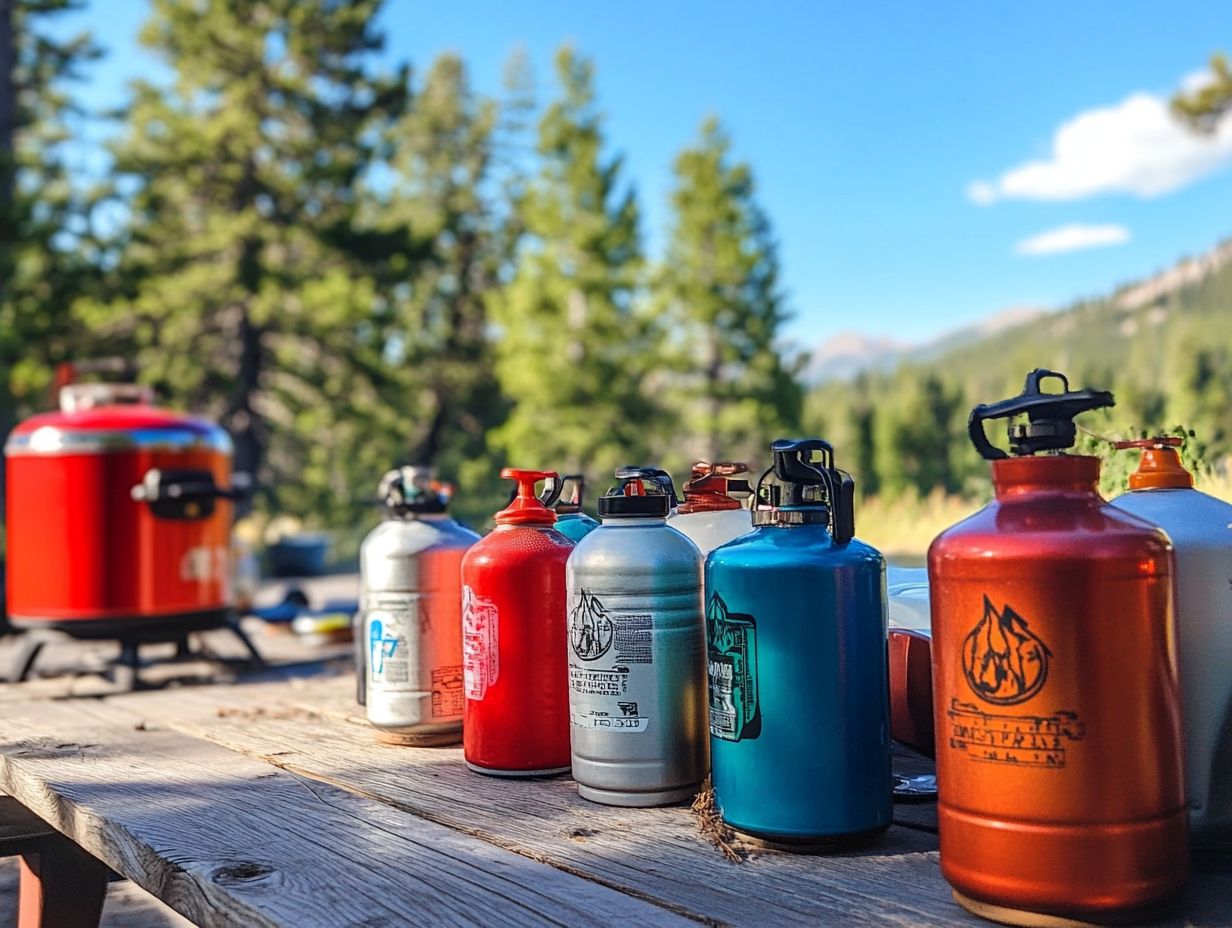
Understanding your cooking needs is essential for selecting the right camping fuel. Various outdoor cooking scenarios demand different levels of heat output and flame control.
If you envision boiling water swiftly or whipping up intricate meals, a powerful camping stove running on canister gas or propane is likely your best bet. Conversely, for lightweight backpacking, simple options like an alcohol burner can do the trick.
Tailoring your fuel choice to your cooking style enhances efficiency and elevates your satisfaction during outdoor adventures. For example, if a hearty breakfast of scrambled eggs and bacon sounds appealing, a high-output stove will help you achieve that perfectly crispy texture in no time.
A simple trail mix might only require a compact, low-heat solution. Some campers may find themselves in winter conditions, where a stove designed for extreme cold is crucial for reliable performance.
By grasping how your cooking requirements influence the choice between campfires, canister stoves, or other alternatives, you lay the groundwork for a truly successful culinary experience in the great outdoors. So gear up, make your choice wisely, and get ready for an unforgettable outdoor cooking experience!
Popular Types of Camping Fuel
Among outdoor enthusiasts, a variety of popular camping fuels exist, each with unique properties tailored to different cooking needs and preferences.
Propane and butane fuel canisters are often your go-to choice for their ease of use and portability. They make perfect quick cooking solutions. In contrast, white gas is celebrated for its high heat output and efficiency, especially during extended camping trips.
Kerosene stands out for its cost-effectiveness and widespread availability. Then there’s wood, which offers a traditional approach appealing to those who crave an authentic camping experience; though it does require a bit more preparation.
Propane
Propane stands out as a top choice for campers, thanks to its impressive versatility and efficiency with camping stoves. It is an essential element of many outdoor kits. Its high heat output and quick ignition are key reasons why propane camping stoves are trusted for reliability.
Whether you’re a casual camper or a seasoned outdoor aficionado, discover a fantastic array of propane-compatible camping stoves waiting just for you!
While propane offers significant advantages like boiling water in minutes and cooking meals to perfection there are a few challenges to keep in mind. You need to consider the safe storage and careful handling of fuel canisters. Also, consider the weight of propane tanks when planning your trips.
To enhance your camping experience, you might want to look into models like the Coleman Portable Gas Stove and the Jetboil Flash Cooking System. Both are celebrated for their performance and portability, ensuring that every camping adventure is convenient and enjoyable.
Butane
Butane, often viewed as the lighter sibling of propane, is a popular fuel choice among outdoor enthusiasts. Its robust flame is perfect for quick cooking tasks on the trail, and small, portable fuel canisters are convenient for backpackers.
However, butane’s performance can suffer in colder temperatures, which may limit its effectiveness during winter camping. For the best experience, use butane in temperatures above freezing, ideally around 50 F (10 C), to ensure a consistent and powerful flame.
While butane excels in moderate conditions, braving the cold may necessitate extra insulation or a switch to propane blends designed for low temperatures. Unlike propane, butane doesn’t turn into gas as efficiently in chilly weather, which can result in cooking delays.
Being mindful of the temperature and selecting the right fuel can significantly enhance your cooking experience.
White Gas
White gas is often regarded as one of the most effective fuels for camping stoves, thanks to its impressive heat output and efficient burn rate. It s no wonder it s a favorite among serious campers.
This liquid fuel option is especially advantageous for extended trips, where minimizing weight while maximizing cooking capability is key. However, using white gas requires a bit more expertise in stove operation and safety precautions.
While it shines in cold weather and high-altitude situations, it also has drawbacks, such as careful handling to prevent spills and a heightened risk of flammability.
Many seasoned campers gravitate toward reliable models like the MSR WhisperLite or the Coleman Peak 1, both known for their dependability and ease of maintenance.
As you venture into the great outdoors with white gas, ensure proper ventilation, keep the fuel away from heat sources, and regularly check for leaks. This way, you can enjoy a safe and rewarding outdoor cooking experience.
Kerosene
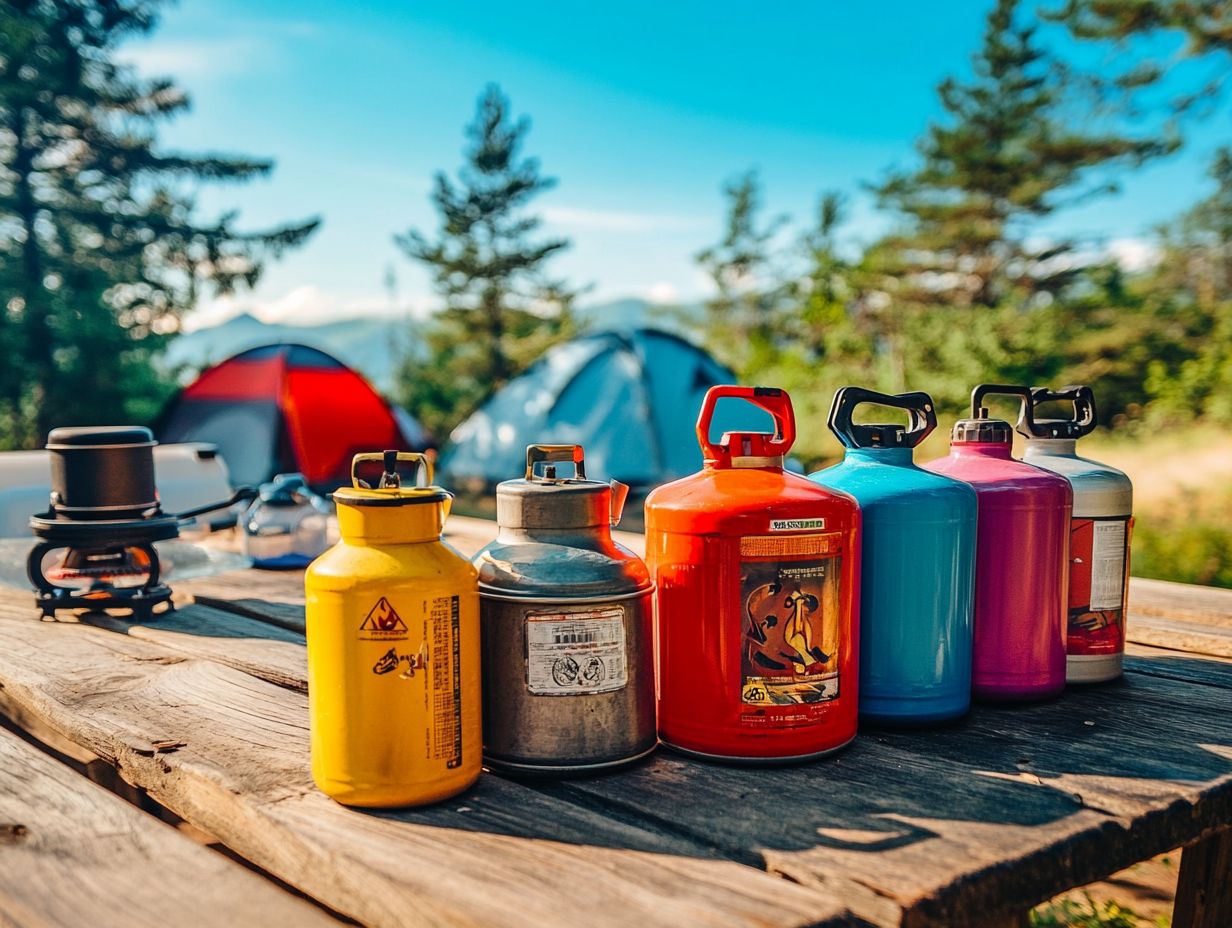
Kerosene stands out as a cost-effective fuel choice for your camping stove, especially in areas where it’s readily available. For budget-conscious outdoor enthusiasts, it offers an appealing solution.
Known for its longevity, kerosene allows extended cooking times without the hassle of frequent refueling. However, it’s important to use stoves specifically designed for this fuel.
While it may not provide the same heat output as white gas or propane, its affordability and accessibility make it a practical option for many camping scenarios. By opting for kerosene, you can embark on longer trips without the constant concern of running out of fuel.
This fuel is less volatile and can be safely transported in larger quantities. However, be mindful of the odor released during burning and prepare for a potentially more complex cleaning and maintenance routine.
If you’re keen on maximizing your kerosene experience, investing in a multi-fuel stove can be a wise move. These stoves adapt to different fuels while ensuring efficient combustion, making them a versatile companion.
Look for models from reputable brands, which often include adjustable settings to control the flame, optimizing your cooking performance across various camping conditions.
Wood
Using wood as a fuel source for cooking while camping offers you a rustic and authentic experience that many outdoor enthusiasts cherish. It seamlessly blends with the natural surroundings.
Wood-burning stoves can be remarkably efficient and impart a unique flavor to your meals, but they demand extra preparation and effort to gather and maintain a fire. Wood availability can change based on your camping location, so plan ahead and adhere to local regulations regarding firewood collection.
The warmth and ambiance of a wood fire enhance your overall camping experience. Preparation involves gathering dry wood and selecting the right types for cooking. Hardwoods, like oak or maple, burn hotter and longer than softwoods, such as pine, making them a preferable choice.
Challenges may arise, such as the risk of smoke inhalation or uneven cooking temperatures. Always keep your fire well-ventilated to avoid smoky meals, and use a grill grate for improved heat distribution.
Incorporating effective wood use into your camping gear means ensuring tools like saws and axes are easily accessible while following safety protocols. Keep a bucket of water nearby for emergencies. With mindful practices, wood can elevate your camp meals, creating lasting memories.
Storage and Safety Tips for Camping Fuel
Safe storage and handling of camping fuel is a must for your safety and the longevity of the fuel itself. This requires careful storage and handling techniques.
Whether you’re using propane, butane, or white gas, always keep your fuel canisters in a cool, dry location, away from direct sunlight and heat sources.
By adopting best practices for fuel storage, you minimize potential risks and enhance your overall camping experience, preventing accidents and ensuring your fuel is primed and ready for action when you need it.
Proper Storage Techniques
Implementing proper storage techniques is crucial for maintaining the integrity and safety of your camping fuel, especially for fuel canisters and liquid fuel containers. Store fuel canisters upright in a cool, dry place away from sunlight to reduce the risk of leaks or explosions and ensure your camping stove operates efficiently.
Always check for expiration dates or any signs of damage before using canisters. This simple step greatly enhances your safety during outdoor adventures.
Liquid fuel containers should be secured tightly and kept away from moisture and extreme temperatures. Always store these containers in a well-ventilated area to avoid fume buildup.
Regularly inspect both types of fuel for rust or punctures in the containers to avoid hazardous accidents. Label the containers with the purchase date to easily monitor their shelf life, keeping your camping experience enjoyable and worry-free.
By diligently following these storage practices, you can trust that your fuel will perform reliably when cooking outdoors.
Safety Precautions
When using camping fuel, adhering to safety precautions is paramount to prevent accidents and ensure a secure outdoor cooking experience, especially when operating a camping stove. Always read the manufacturer s guidelines regarding fuel and stove compatibility, and ensure proper ventilation while cooking to avoid harmful gas buildup.
Be mindful of your fuel requirements, as various fuels may need specialized handling techniques to minimize the risks of burns or explosions.
Store fuel in a cool, dry place, away from direct sunlight and heat sources. This practice significantly reduces the risk of flare-ups or leaks. Before igniting your stove, check for leaks in the fuel line or seals and conduct a quick visual inspection to confirm that everything is in order.
In case of an emergency, such as a fire or spill, having a fire extinguisher or a bucket of sand nearby can truly make a difference. By following these practices, you cultivate a safer environment while relishing your outdoor culinary adventures.
Frequently Asked Questions
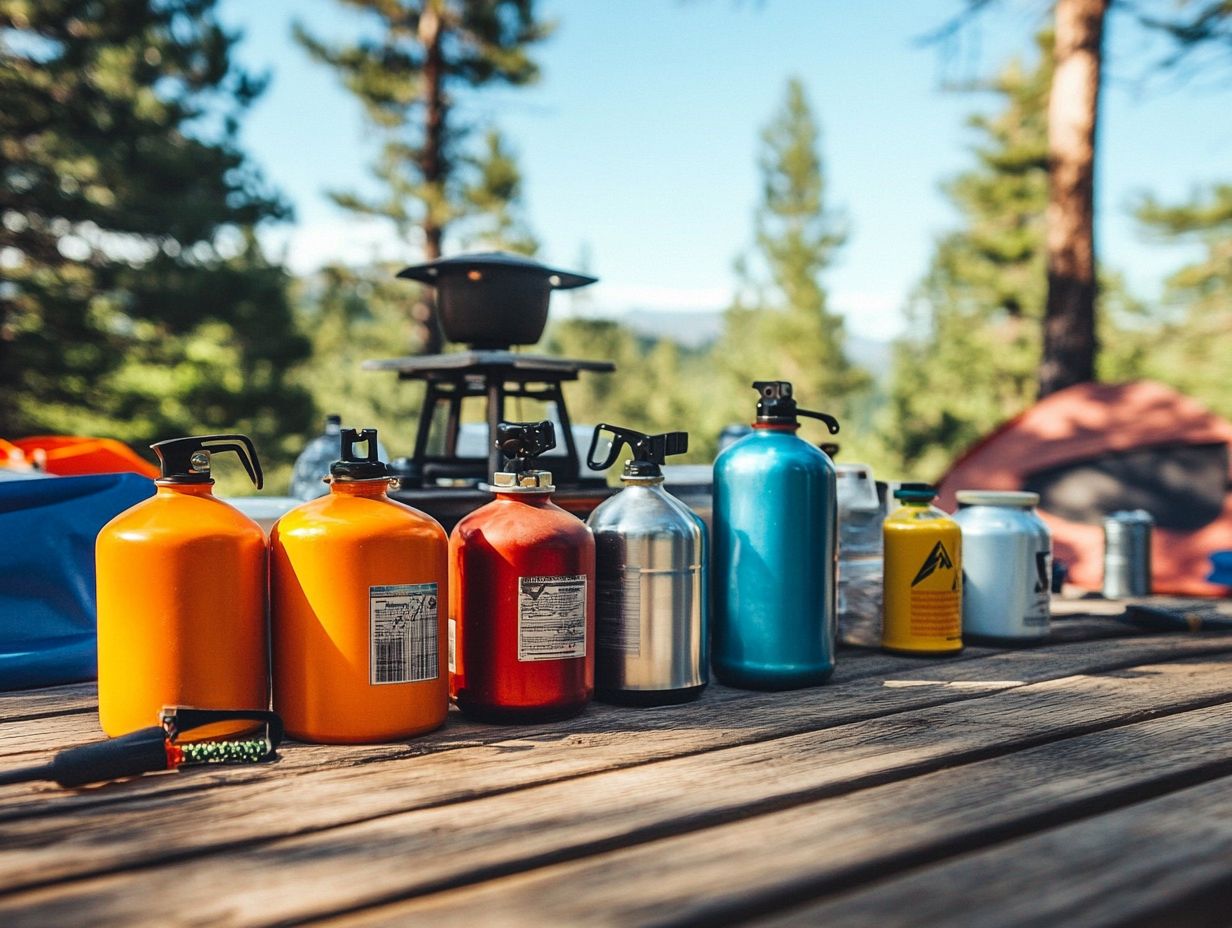
What factors should I consider when selecting the right camping fuel?
When selecting the right camping fuel, consider the type of stove you will be using and the duration of your trip. Don’t forget about the weather conditions and the availability of the fuel at your destination.
What are the different types of camping fuel available in the market?
The most common types of camping fuel are propane, butane, isobutane, white gas, kerosene, and alcohol. Each has its own special features and is suitable for different types of camping stoves.
Can I use any type of fuel for my camping stove?
Absolutely! Always use the fuel your camping stove needs for the best experience. Using the wrong type of fuel can be dangerous and can damage your stove.
What is the best type of camping fuel for cold weather?
If you are camping in cold weather, it is best to use white gas or kerosene. These fuels perform better in low temperatures compared to propane or butane.
They tend to have a higher heat output.
How should I store camping fuel while on a camping trip?
Camping fuel should always be stored in a cool, dry place, away from direct sunlight and sources of heat. Properly sealing the container is also crucial to avoid any spills or leaks.
Can I bring camping fuel on a plane?
No, most airlines do not allow passengers to bring camping fuel on board. Grab your fuel at your destination to avoid any hassle!
Now that you’re equipped with this knowledge, get ready for your next camping adventure!


